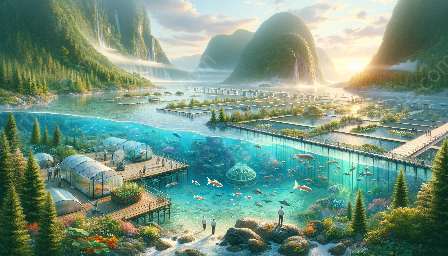As the demand for seafood continues to rise, sustainable fish farming is gaining momentum as a responsible and eco-friendly method to supply the world with high-quality fish products. In this topic cluster, we will explore the principles, methods, and technologies behind sustainable fish farming and its impact on aquaculture and fisheries science. We will delve into the applied sciences that play a crucial role in ensuring the health and productivity of fish farming operations while maintaining environmental balance.
The Importance of Sustainable Fish Farming
Sustainable fish farming, also known as aquaculture, is essential for meeting the growing demand for seafood while reducing the strain on natural fish populations and ecosystems. By adopting sustainable practices, fish farming can contribute to food security, economic development, and environmental conservation. Moreover, sustainable fish farming reduces overfishing pressure, preserves marine biodiversity, and supports the livelihoods of coastal communities.
Techniques and Best Practices in Sustainable Fish Farming
Several techniques and best practices are employed in sustainable fish farming to ensure ethical and environmentally-friendly operations. These include responsible feed management, efficient water usage, disease prevention, and waste management. Additionally, the use of sustainable feed sources, such as algae and insect-based feeds, reduces the reliance on wild fish for fish feed. These practices not only improve the quality of farmed fish but also minimize the environmental impact of fish farming.
Applied Sciences in Sustainable Fish Farming
The field of applied sciences plays a critical role in the advancement of sustainable fish farming. Research and innovation in aquaculture and fisheries science contribute to the development of sustainable farming methods, disease management strategies, and the utilization of advanced technologies. Biotechnology, genetics, aquaculture engineering, and environmental monitoring are some of the key areas within applied sciences that drive the sustainable transformation of fish farming.
Environmental Impact and Conservation Efforts
One of the primary goals of sustainable fish farming is to minimize its environmental impact and contribute to conservation efforts. Efforts are made to reduce the discharge of pollutants into water bodies, prevent the escape of farmed fish into the wild, and preserve the natural habitats of marine and freshwater species. Furthermore, sustainable fish farming promotes responsible spatial planning and the integration of aquaculture with coastal and marine ecosystems, thereby fostering biodiversity and ecosystem resilience.
Advancements and Future Prospects
With ongoing advancements in technology and scientific knowledge, the future of sustainable fish farming looks promising. Innovations in aquaculture and fisheries science, such as recirculating aquaculture systems, integrated multi-trophic aquaculture, and selective breeding for disease resistance and improved growth rates, are enhancing the sustainability and efficiency of fish farming operations. Additionally, the adoption of digital technologies for monitoring, precision feeding, and data analysis is revolutionizing the way fish farms are managed.
Conclusion
Sustainable fish farming is not just a method of production, but a commitment to environmental stewardship, social responsibility, and long-term food security. By embracing sustainable practices and leveraging the advancements in aquaculture and fisheries science, the global fish farming industry can thrive while ensuring the protection of natural resources and ecosystems. As consumers, industry stakeholders, and researchers continue to advocate for sustainable fish farming, the future of aquaculture looks bright and sustainable for generations to come.

